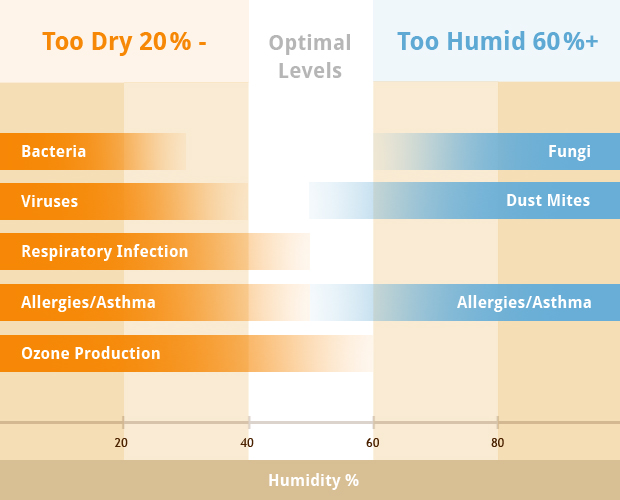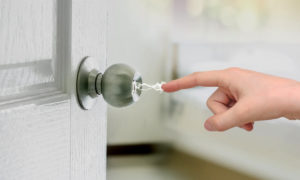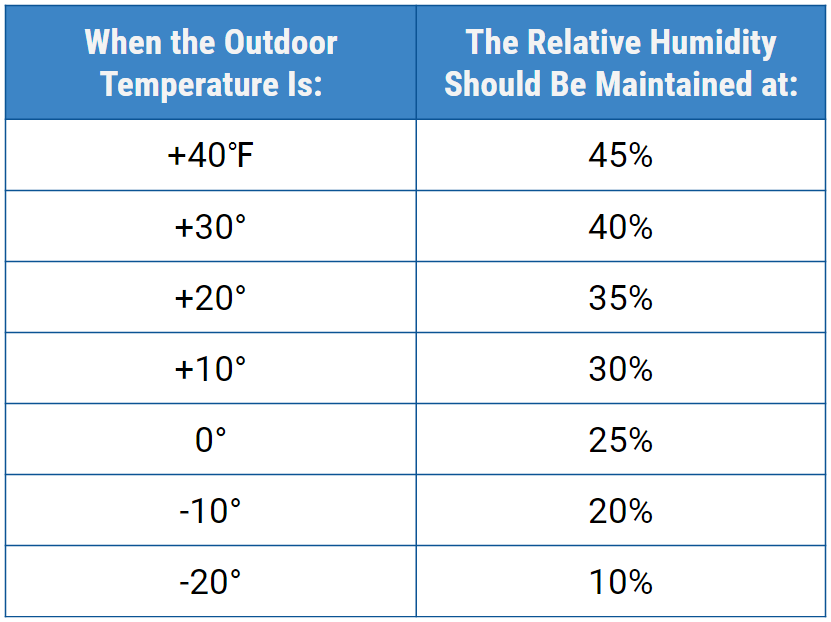People often ask what humidity should my house be?
Recommended Humidity Level is 50%
Regardless of the area in which a home is located, the levels of humidity determine its comfort significantly as well as the efficiency of the HVAC system. Too much or too low moisture often carries detrimental effects to the home and its occupants, which makes it necessary to keep the humidity at the recommended levels ranging between 40% and 60% also known as humidity comfort level. Maintaining it around this range goes a long way in providing the residents with the best level of comfort while also protecting the dry walls, musical instruments and household items such as wooden furniture from the damaging effects of excessive moisture or extreme dryness.
Given that the humidity levels fluctuate depending on the climatic changes and temperature, it’s recommended that every homeowner use a meter to keep track and control the levels of moisture in the indoor environment. Below are some compelling reasons why it’s essential to monitor the levels of humidity in a home.
Improved Overall Health
Reduced humidity levels imply that the air inside the home is dry. Without the moisture, the occupants become exposed to several health issues including dry nose and throat as well as increased risk of catching a cold. It also causes the skin to dry, which might affect numerous metabolic functions including oxygen intake. Low humidity may also cause the body to experience excessive water evaporation.
Reduced humidity is very common in areas experiencing colder climates. This is because cold air doesn’t hold water vapor effectively. To determine whether the indoor air is sufficiently humid, homeowners can utilize humidity meters or otherwise place a glass of iced water far from the kitchen or bathroom. If there are no water droplets on the external sides of the glass, then the humidity level in the home is too low. They should, therefore, get a humidifier to increase the moisture levels in the indoor atmosphere.
Avoiding Allergies and Respiratory Issues
On the other hand, nobody wants the home to experience excessive humidity. This is because mold thrives best in damp areas and subsequently produces spores that can impact negatively on one’s health. When inhaled, these spores affect the normal functioning of the human’s immune system. They also lead to allergic reactions and cause difficulty in breathing especially among people with respiratory complications. Mold is also notoriously known to produce a musty smell that a lot of people find to be repulsive.

Also, excessive moisture in a home causes the growth of dust mites. These are microscopic organisms that generate some of the most common indoor allergies that consequently trigger asthmatic reactions. Dust mites thrive best in materials like beddings, mattresses, carpets, curtains, and furniture upholstery. While dust mites don’t bite, burrow or sting the body, their fecal pellets and body fragments often cause allergic reactions. Among the most effective methods of combating both mold and dust mites is reducing the moisture levels in the indoor environment.
Preventing Static Electricity and Equipment Failure

When the relative humidity in a home becomes less than 45%, the house becomes susceptible to the accumulation of electrostatic charges. These charges often accumulate inside IT equipment like computers, routers, and headsets. Static energy occurs in the indoor environment due to the friction of materials having high electrical resistance. While electrical charges are not hazardous, the problem begins when they’re allowed to accumulate. Not only do they cause unpleasant feelings when a person receives a charge, but they are also extremely dangerous in the presence of an explosive or inflammable substance.
Moreover, electrostatic energy can cause problems including electrical faults in the circuits and dust accumulation on reader heads, which causes
defects in home appliances like DVDs and computers. It also causes damage to the stored magnetic media in hard disk drives, floppy disks, and computer tapes. While increasing the humidity levels doesn’t exactly prevent the formation of static charges, it does prevent their accumulation. Improved humidity provides a layer of moisture on the surfaces of the susceptible materials, which allows the electrical charge to travel to the earth rather than accumulating inside the house.
Averting Damage to Household Items
From damaging wooden furniture to ruining photo albums, failure to control indoor humidity will ultimately prove to be disastrous for most household items. For instance, the structural integrity of wooden furniture can be significantly affected by either low or high humidity levels. This is because wood absorbs moisture and subsequently lose it as the humidity levels change. In doing so, the furniture shrinks and swell and thus cause the joints to become loose or even pull apart. Wooden floors also suffer the same fate and consequently bend, which will lead to unsightly gaps in the flooring. High humidity levels also affect the sound produced by musical instruments such as guitars, pianos, and microphones.
In addition, extremely low moisture levels can cause book pages to become brittle and fragile while excessive humidity leads to wrinkles, warped covers and flanking ink. Low moisture level doesn’t spare the wine either. It causes the crock to dry, shrink and crack thus allowing air to come into contact with the wine as a result of which it loses its natural taste. Reduced humidity also leads to flaking of the photo emulsion as a consequence of which they become damaged.
It should be noted that excessive moisture leads to mold growth that can ruin drywalls, upholstery, and clothing. Excessive mold growth also causes dry rot in wood, which might threaten the structural integrity of a home. Maintaining the right levels of humidity in a home will, therefore, go a long way in preserving the quality of household items.
Maintaining Optimal Comfort
Most people blame the scorching summer temperatures when they feel overheated; little do they know that humidity plays a significant role in their discomfort. Excessive moisture in the air inhibits the body’s ability to release heat through sweating. When the surrounding air is already saturated, excessive heat gets trapped inside the body, which makes people feel hotter than their surroundings. Extreme humidity also makes a home feel muggy in addition to disrupting a person’s sleeping patterns. Conversely, low moisture levels in the indoor air cause the eyes to become dry and irritated and the skin flaky and itchy. The ideal indoor humidity varies depending on the various climatic zones.
It is, therefore, advisable for homeowners to check out below home humidity levels chart to get an insight on how to properly control the moisture in a house.

Preserving the Efficiency of the HVAC Systems
Diverse humidity levels brought about by different climates also affect the performance of the HVAC system significantly. Given that the unit is tasked with cooling a home, it’s logical that the process will take a toll on the system during the summer. This is because summer is characterized by a rise in humidity levels, which makes the home harder to cool. As such, the homeowner will have to keep the system running for a longer period to provide the desired results, which causes untimely wear of the unit in addition to increasing the energy bills. On the other hand, low humidity, especially during the winter causes the heating system to work twice as hard to provide the required warmth. This is why homeowners should find effective methods of keeping the moisture in the indoor environment at the recommended levels.
Humidity levels in house need to be effectively controlled as they carry a significant impact on the indoor temperature, health, air quality as well as Heating and cooling appliances. Different climatic conditions determine the amount of moisture in the air, which consequently affects the effectiveness of the HVAC unit. Also. When the indoor humidity is high, people suffer from allergic reactions because of mold growth, while, on the other hand, low moisture levels cause dry eyes and itchy skin. The wooden items in a home can also become damaged due to shrinking and swelling in response to the changes in humidity levels.The Bottom Line
